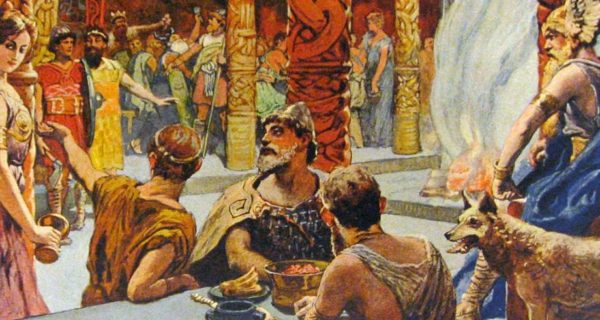What is the Druidic tradition of spirituality conveyed through storytelling, and what were some of Tolkien’s inspirations taken from Pagan Myth? OK, big subject this, and it’s not possible to provide more than a quick overview here. First things first, though – I belong to the British Druid Order and another group called Discover Druidry. Both have their own websites and Facebook sites, with extensive articles and further reading sources. The other main druidic body is the Order of Bards, Ovates and Druids (OBOD).
The druidic spiritual tradition centres on the concept of Awen (pronounced “ah-oo-en”), based on a design from the Druid revival poet, Iolo Morganwg. It shows 3 rays of light from 3 points of light and symbolises the druid path of bards, ovates and druids. The Awen means the flowing spirit and is like a journey of discovery – the earliest written reference to it was 796 CE in the Historia Brittonum.
However, the concept of Awen came from Ireland and was closely aligned with poetry and storytelling – before the times of St Augustine (Picts) and St Columba (Iona) and only a century or so after St Patrick. Awen can be placed at a time when Ireland was moving from Pagan Druidry to Christianity. Later medieval sources, such as the Four Ancient Books of Wales, contain poems that refer to the Awen, which had then become part of the Christian bardic or storytelling tradition.
But what is a bard? A bard (for the Celts) was a respected part of the community – a poet and storyteller who had trained in a bardic college. Modern druidic bards train their creativity in a similar fashion. Back to the bards of 2000+ years ago – they kept the lore, laws and lineage of the community, a keeper of traditions – and some would continue their training to become ovates and druids, as they do today. The bard would reiterate the epic tales for the community, accentuate the three realms (earth, sea and sky) and maintain the spiritual values.
Many books and monographs have been written about the various sources of myths, used by Tolkien for his stories. For example, Smaug was an archetypal firedrake from Beowulf (as translated by Tolkien), as opposed to other types of dragons – wyverns or Saxon wyrms. Gandalf was likened to an Odinic simile by Tolkien himself, and Galadriel was derived from the Welsh goddess, Ceridwen. Some of these deities have given rise to modern religions in their own right.
We can discern the Norse/Germanic/Heathen influences on Tolkien from the myth-pools of Finland, Germany, Scandinavia, Anglo-Saxon England, Wales, and Iceland, as well as those put forward by authors such as Shakespeare, Dickens and Jules Verne. All can be read in more detail in the Humphrey Carpenter biography. “Certh” are Tolkien’s invented runes, based on real runic characters from Norse/Germanic sources. The real runes are also used in Icelandic script and can be seen today in Asatru temples or manuscripts.
Another example of a mythic inspiration for Tolkien are the dwarfs – a race created by Aulë at the start of the Quenta Silmarillion. But dwarfs have an interesting myth-pool of their own, with a folk character that was a skilled smith and rock worker, known as a dvergr (Old Norse), dweorg (Old English), twerg (Old High German) or dwergaz (Proto-Germanic). In Anglo-Saxon areas, the idea of a goblin that was the opposite of an elf/ puca/pook took the name of a dwergl. And Tolkien, with his Saxon language skills, would have been well aware of the dwarf, in its evolution over the centuries from the gnomes of Paracelsian law, ruled by King Ghob – from whom we derive the word, goblin.
And so, we come to a new concept, which I put forward for your reflection, i.e. that of Zeitgeist! To fully understand Tolkien’s literature from a pagan perspective, one has to know the timeline – of course, many people became devoted followers of JRR Tolkien in the 1960s, when LotR was produced in paperback, but the question has to be that of how much influence was exerted on the author by the evolution of neo-paganism?
Paganism is an umbrella term that covers many pathways, in the same way that Christianity is an over-arching descriptor. For example, all druids are pagans, but not all pagans are druids. Let’s take a brief look at Tolkien’s life from the end of WW1 to his university posts and writing up to 1950, and now compare those events with the tumultuous changes occurring in British spirituality, as below.
- The ongoing influence of the Hermetic Order of Golden Dawn (from 1890s-1920s) with Aleister Crowley.
- Launch of the Ancient Druid Order in 1909.
- The continuing work of the Theosophical Society from the late Victorian era under Madame Blavatsky and Walter Evans-Wentz (who authored a key work in 1911, Fairy Faith in Celtic Countries).
- The Cottingley Fae event in July 1917 and the launch of the Fairy Investigation Society in 1926 (with a clear theosophist agenda).
- In the mid-1930s, Gerald Gardner developed Wiccan belief, with Doreen Valiente and the Bricket Wood coven.
- In 1947, Robert Graves authored The White Goddess, which inspired a neo-druid revival.
- In 1951, due to the explosion of new British occult popularity, the ‘Witchcraft Act 1753’ was replaced by the ‘Fraudulent Mediums Act.’
Evolutionary paganism was a hot topic at exactly the same time that Tolkien was researching various myths for his writing. It is suggested here that Tolkien could not fail to be caught up in the cultural and spiritual trend happening in the UK in the first part of the last century. Despite his Catholicism, his curiosity as an author could not fail to have been piqued by the neo-beliefs springing up around him. It is clear that many of these pagan traditions found their way into his writings.

